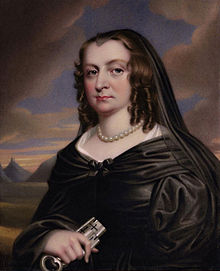Mary Bankes
| Mary Bankes | |
|---|---|
 |
|
| Born |
Mary Hawtry 8 Aug 1603 Ruislip, Middlesex, England |
| Died | 11 April 1661 |
| Known for | Her defence of Corfe Castle against a three-year Parliamentarian siege during the English Civil War |
| Spouse(s) | Sir John Bankes |
| Children | Sir Ralph Bankes Jerome Bankes Charles Bankes William Bankes Alice Bankes Jane Bankes Mary Bankes Joanna Bankes Elizabeth Bankes Arabella Bankes |
Mary, Lady Bankes née Hawtry (c. 1598 – 11 April 1661) was a Royalist who defended Corfe Castle from a three-year siege during the English Civil War from 1643 to 1646. She was married to Sir John Bankes, Lord Chief Justice of the Common Pleas and Attorney-General of King Charles I.
Mary Hawtry was born in about 1598, the only daughter of Ralph Hawtry, Esquire of Ruislip, Middlesex, and Mary Altham. In about 1618, she married Sir John Bankes, who later became Attorney-General to King Charles I and Lord Chief Justice of the Common Pleas. In 1635, Sir John purchased Corfe Castle in Dorset with all its manors, rights, and privileges from Lady Elizabeth Coke. Sir John died on 28 December 1644 at the age of 55.
Together Sir John and Mary had four sons and six daughters:
In 1643, when civil war broke out in England, she assumed control of Corfe Castle when John Bankes had been ordered by the king to travel to York. She sent her sons away for safety and remained behind with her daughters, servants, and a force of five men. In May 1643, a force of Parliamentarians, comprising between 200 and 300 men under the command of Sir Walter Erle attacked the castle but never succeeded in capturing it. She asked for aid and a troop of 80 men under the command of Captain Robert Lawrence arrived to reinforce the garrison. In June, Commander Erle renewed his attack along with Captains Sydenham, Jarvis and Scott, a force of 500-600 men, and two siege engines. With Captain Lawrence's troops protecting the Middle Ward and the better part of the garrison, Mary and her small group defended the Upper Ward and by heaving stones and hot embers from the battlements, managed to repel the assailants, killing and wounding over 100 men. In 1646, one of her officers, Colonel Pitman, betrayed her by leading a party of Parliamentarians into the castle via a sally gate. The Parliamentarians under the command of a Colonel Bingham reversed their jackets and were mistaken for Royalists. As a result, she was forced to surrender the castle. However, because she showed such courage she was allowed to keep the keys of the castle, which are now held at Kingston Lacy near Wimborne Minster, Dorset. The castle was slighted the same year it was captured by the orders of the House of Commons.
...
Wikipedia
